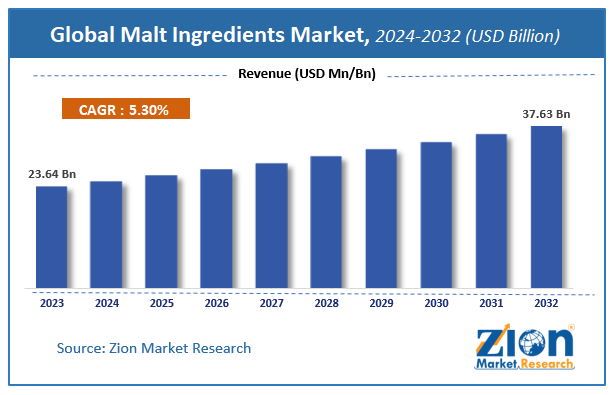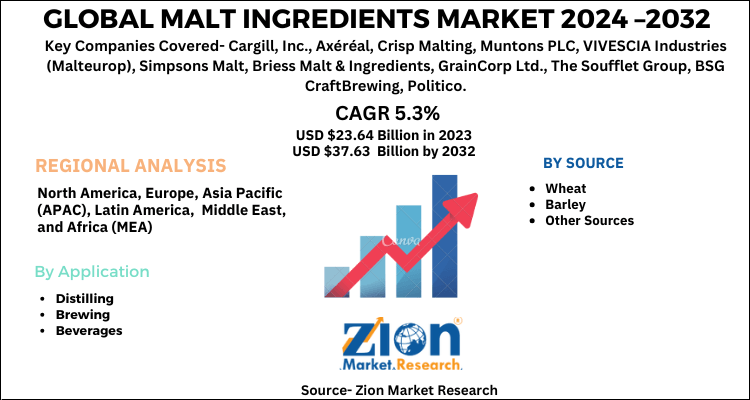Malt Ingredients Market Size, Share, Analysis, Trends, Growth, 2032

Malt Ingredients Market, By Source (Barley, Wheat and Rye Malt), By Application (Food Industry, Alcoholic Beverages, and Non-Alcoholic Beverages, Pharmaceutical Industry (Supplements) and Others.), and By Region: Global Industry Perspective, Comprehensive Analysis and Forecast, 2024 - 2032-
| Market Size in 2023 | Market Forecast in 2032 | CAGR (in %) | Base Year |
|---|---|---|---|
| USD 23.64 Billion | USD 37.63 Billion | 5.3% | 2023 |
Malt Ingredients Market Insights
According to Zion Market Research, the global Malt Ingredients Market was worth USD 23.64 Billion in 2023. The market is forecast to reach USD 37.63 Billion by 2032, growing at a compound annual growth rate (CAGR) of 5.3% during the forecast period 2024-2032. The report offers a comprehensive analysis of the market, highlighting the factors that will determine growth, potential challenges, and opportunities that could emerge in the Malt Ingredients Market industry over the next decade.
Global Malt Ingredients Market: Overview
Malt is the leftover cereal grains that are allowed to dry and then germinate. Generally, barley grain is used as a malt ingredient which is soaked in water and then allowed to germinate. This process is known as malting. In this process, the starch present in ingredients is converted to sugars such as glucose and fructose. The malt ingredients have large scope in the food and beverages industry. Malt ingredients help to enhance the flavor and texture of various food products. These ingredients are mainly used to prepare different drinks and confectionary such as Maltesers and whoppers, beer, whisky, malted shakes, malt vinegar, Horlicks, Ovaltine, milo, malt loaf, bagels, and rich tea biscuits.
Global Malt Ingredients Market: Growth Factors
The malt ingredients market is primarily driven by rising demand from the food & beverage industry across the globe. Increasing demand for dairy products and beer is also expected to fuel the demand for malt ingredients in the years to come. The market for convenience food is growing positively and expects to grow further, and it is likely to add to the demand for malt ingredients. Increasing health consciousness has also widened the product application scope in the food industry. Malt extracts are widely used as colorants, flavors, and additives in the manufacturing of snack bars, cookies, flakes, milk powder, and nutritional syrups. Beer as a beverage is preferred by the young population across the world, and as this aspirational class is likely to grow in the forecast period demand for malt ingredients has better prospects in the future. However, seasonal variations and availability of good quality cereal grains are likely to limit the growth of the global ingredients market. Nonetheless, the emerging market for malt ingredients is expected to open new opportunities in near future.
Global Malt Ingredients Market: Segmentation
The global malt ingredients market is segmented on the basis of source, applications, and region.
The source segmentation covered in this study includes barley, wheat, and rye malt.
The major application segment covered in this study includes the food industry, alcoholic beverages, non-alcoholic beverages, the pharmaceutical industry (supplements), and others. Moreover, the market size and forecasts in terms of volume (kilo tons) and revenue (USD million) for the period 2016 to 2021, considering 2015 as the base year, have been provided for this segment of the report. The report also provides the compounded annual growth rate (% CAGR) for the forecast period from 2016 to 2021.
Malt Ingredients Market: Report Scope
| Report Attributes | Report Details |
|---|---|
| Report Name | Malt Ingredients Market |
| Market Size in 2023 | USD 23.64 Billion |
| Market Forecast in 2032 | USD 37.63 Billion |
| Growth Rate | CAGR of 5.3% |
| Number of Pages | 110 |
| Key Companies Covered | Cargill, Inc., Axéréal, Crisp Malting, Muntons PLC, VIVESCIA Industries (Malteurop), Simpsons Malt, Briess Malt & Ingredients, GrainCorp Ltd., The Soufflet Group, BSG CraftBrewing, Politico. |
| Segments Covered | By Product Type, By Application And By Region |
| Regions Covered | North America, Europe, Asia Pacific (APAC), Latin America, Middle East, and Africa (MEA) |
| Base Year | 2023 |
| Historical Year | 2018 to 2022 |
| Forecast Year | 2024 - 2032 |
| Customization Scope | Avail customized purchase options to meet your exact research needs. Request For Customization |
To know more about this report, request a sample copy.
Global Malt Ingredients Market: Regional Analysis
Based on regional segmentation, the study covers diverse regions and countries such as North America, Latin America, the Middle East, and Africa, Asia-Pacific, and Europe. The report also includes further bifurcation into major countries including the U.S., Germany, France, the UK, China, Japan, India, and Brazil. This segmentation includes demand for malt ingredients market based on individual applications in all the regions and countries.
In terms of regions, Europe was the leading regional market for malt ingredients market in 2024. Furthermore, Europe is expected to continue its dominance over the malt ingredient market throughout the forecast period due to the growing rate of packaged food consumption in the region. In addition, Asia Pacific is the fastest growing regional market for malt ingredients owing to the growing demand for non-alcoholic and alcoholic drinks. The Middle East & Africa are also other promising markets for malt ingredients in near future.
Global Malt Ingredients Market: Competitive Players
Some of the significant players in the global sales performance management market are
- Cargill, Inc.
- Axéréal
- Crisp Malting
- Muntons PLC
- VIVESCIA Industries (Malteurop)
- Simpsons Malt
- Briess Malt & Ingredients
- GrainCorp Ltd.
- The Soufflet Group
- BSG CraftBrewing
- Politico.
The global malt ingredients market is segmented as follows:
By Application
- Distilling
- Brewing
- Beverages
- Non-alcoholic
- Alcoholic
- Bakery Services
By Source
- Wheat
- Barley
- Other Sources
Global Malt Ingredients Market: Regional Segment Analysis
- North America
- The U.S.
- Canada
- Europe
- France
- The UK
- Spain
- Germany
- Italy
- Rest of Europe
- Asia Pacific
- China
- Japan
- India
- South Korea
- Southeast Asia
- Rest of Asia Pacific
- Latin America
- Brazil
- Mexico
- Rest of Latin America
- Middle East & Africa
- GCC
- South Africa
- Rest of The Middle East & Africa
Table Of Content
Methodology
FrequentlyAsked Questions
The malt ingredients market is primarily driven by rising demand from food & beverage industry across the globe. Increasing demand for dairy products and beer is also expected to fuel the demand for malt ingredient during the years to come.
According to the report published by Zion Market Research, global global Malt Ingredients Market was worth USD 23.64 Billion in 2023. The market is forecast to reach USD 37.63 Billion by 2032, growing at a compound annual growth rate (CAGR) of 5.3% during the forecast period 2024-2032.
In terms of regions, Europe was leading regional market for malt ingredients market in 2024. Furthermore, Europe is expected to continue the dominance over the malt ingredient market throughout the forecast period due to growing rate of packaged food consumption in the region. In addition, Asia Pacific is a fastest growing regional market for malt ingredients owing to growing demand for non-alcoholic and alcoholic drinks. The Middle East & Africa is also another promising market for malt ingredients in near future.
Some of the significant players in the global sales performance management market are Cargill, Inc.; Axéréal; Crisp Malting; Muntons PLC; VIVESCIA Industries (Malteurop); Simpsons Malt; Briess Malt & Ingredients; GrainCorp Ltd.; The Soufflet Group; BSG CraftBrewing; Polttimo.
RelatedNews
HappyClients
Zion Market Research
Tel: +1 (302) 444-0166
USA/Canada Toll Free No.+1 (855) 465-4651
3rd Floor,
Mrunal Paradise, Opp Maharaja Hotel,
Pimple Gurav, Pune 411061,
Maharashtra, India
Phone No +91 7768 006 007, +91 7768 006 008
US OFFICE NO +1 (302) 444-0166
US/CAN TOLL FREE +1 (855) 465-4651
Email: sales@zionmarketresearch.com
We have secured system to process your transaction.
Our support available to help you 24 hours a day, five days a week.
Monday - Friday: 9AM - 6PM
Saturday - Sunday: Closed






